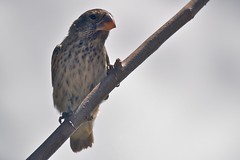
(Slightly off-topic: Len has found large numbers of bird photos in Flickr labeled Darwin's Finches that are in fact other species, such as mockingbirds, warblers, or flycatchers. Whatever.)
The giant tortoises -- different species on almost every island -- might be more famous than the finches. For centuries, whalers and pirates loaded them onto their ships where they survived, thanks to their adaptation to the unfavorable conditions of the islands. As a result they were a perfect way to carry fresh meat on a long sea voyage. The tortoise populations of some islands went extinct from this practice -- and the survivors were then threatened by introduced goats, rats, dogs, and cats. Most turtle breeding is now done at the Darwin Research Center on Santa Cruz Island.

The most famous giant tortoise of all is named Lonesome George. He lives in the Darwin Center in a kind of leisurely retirement. George is the last member of the tortoise species that once inhabited Pinta Island. The tortoise above is similar, but the photo is not George.
Penguins are the most unexpected species: who would think of seeing a penguin in a mangrove swamp?
 On more than one zodiac tour, penguins sat right next to the water’s edge as our boat came up for all of us photographers to snap a close-up.
On more than one zodiac tour, penguins sat right next to the water’s edge as our boat came up for all of us photographers to snap a close-up.Every day in the islands we saw new wildlife, often up very close. Many species that are normally not very approachable ignore human presence. A type of mockingbird that lives only on Espanola Island, for example, has learned that humans carry water in their packs.
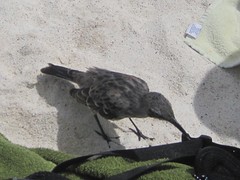 If you leave your pack on the beach near where you are sitting -- a normal thing to do -- the mockingbird will light on your pack and peer inside or will sip a drop of water from the lid of your bottle. (Incidentally, Darwin observed the differences in Galapagos mockingbird species before he got onto the finches, but that’s a long story.)
If you leave your pack on the beach near where you are sitting -- a normal thing to do -- the mockingbird will light on your pack and peer inside or will sip a drop of water from the lid of your bottle. (Incidentally, Darwin observed the differences in Galapagos mockingbird species before he got onto the finches, but that’s a long story.)Other birds throughout the islands are also very unafraid. The blue-footed booby does a mating dance or sits on a lava rock above the ocean as boats go close by.
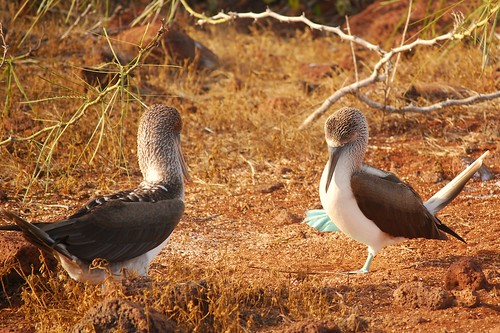
The male frigate bird inflates his neck into a huge red balloon hoping to impress the ladies; they often soar right overhead.

On a rocky area of a wide sandy beach at Espanola Island, an oystercatcher plunged his beak into the wet sand almost at our feet.
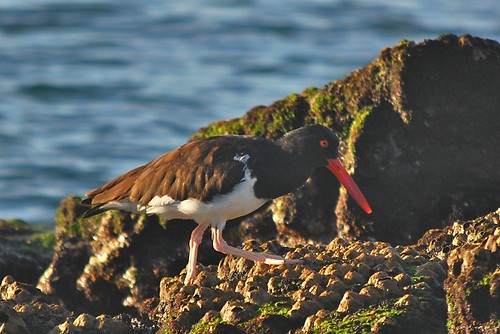
Swallow-tail gulls nest next to the trail at South Plaza Island: one chick was sitting on the base of a signpost.

Brown noddy terns, other gulls and terns, and stormy petrels are everywhere. The terns fly around the boat, perch on rocky outcroppings, and sometimes perch on ropes or rails of the boat. The petrels dance on the water, tilting their wings and dipping up the small bits of plankton.
Most amusing was a flightless cormorant on Isabella Island. He came up to our Zodiac to peck at the ropes: I looked him right in the eye, at a distance of around 8 inches. A few minutes earlier as we snorkeled, we had watched him diving down and catching an urchin. We didn't get a photo of this one, but here are some others:

Brown pelicans beg fish at the fish market in Puerto Ayora every day, or perch right near other human activity. Finches, doves, flycatchers, and warblers flit through the trees and land near the trail, or flock onto the trail right in front of the hikers. At close range, we saw a hawk that had caught a rat. Only the flamingos kept a big distance between the trail and where they were feeding in the shallows, but they may have been driven by the tide, not by the sight of us. Herons, egrets and shore birds were also a bit shyer, though easier to see than similar birds at home.
Our last hike passed an entire field of albatross, along with some hidden in the undergrowth almost on the trail.

Some were doing their mating dance, at least one was sitting on an egg, and others were soaring overhead. With their large wingspan, these may have been the most impressive birds we saw during our tour.
Other species besides birds are also bold and fearless. Male land iguanas puff up and shake their heads in a territory dispute a few feet from the marked trail, or sun themselves right on the trail. Small lizards lie on rocks or dart across the path. Sea lions line the shore and pay no attention when people walk among them. Fur sea-lions (once called Galapagos Seals) were a bit less tame, though we did watch from the Zodiac as a large group of babies were playing in a shallow rocky area. Only the rice rats are elusive – the only one we saw was dead, lying in a small crevasse between two lava rocks.
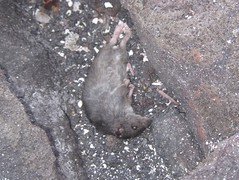
Giant tortoises roaming in the highland areas are probably unable to notice a human until one comes right up in front of them: all they do is draw their heads into their shells. Tortoises in the corrals in the research areas are accustomed to people walking right up to them, and distance is maintained only by the admonishments of the naturalists.
Sea animals on shore are a bit more skittish. Colorful crabs scurry down the rocks when people come towards them, and ghost crabs tend to stay in their holes.
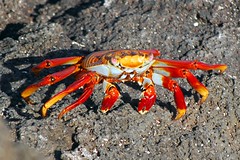
Sea turtles reenter the water if you catch them basking in the sand: odd, as they are less nervous on the beaches in Hawaii. We observed a small eel trapped in a tidepool right at our feet, but he was actually eager to get back into the sea.
In contrast, stinky marine iguanas totally ignore humans. Dozens of them pile up to warm themselves on sand or rocks and don’t move at all when humans walk nearby.
 All they do is snort salt out of the gland on their heads that allows them to drink seawater while munching on sea plants. Their scaly black and red skin, strange faces, long claws, and fringed ridge along the back make them look like the evil imps in a fairy tale. Actually, they are harmless vegetarians.
All they do is snort salt out of the gland on their heads that allows them to drink seawater while munching on sea plants. Their scaly black and red skin, strange faces, long claws, and fringed ridge along the back make them look like the evil imps in a fairy tale. Actually, they are harmless vegetarians.
1 comment:
Mae, your photography is simply stunning. You must have one heck of a lens!
Post a Comment